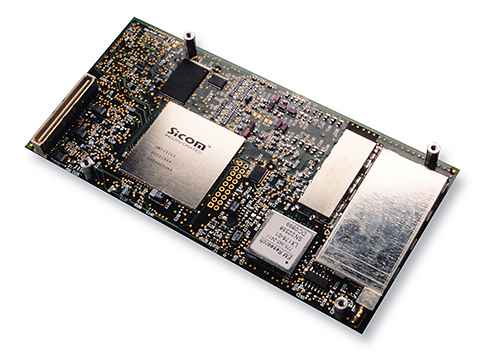Increasing the Flow
Everywhere you go people are looking for increased bandwidth. Whether it is a faster dial-up modem, digital subscriber line (DSL), cable, or a wireless connection, people want to transmit data as fast as they can. The desire for faster data transmission is greater nowhere else than at NASA.
Seeking to increase the speed of wireless communications for space missions, such as the International Space Station and Earth Science missions, NASA's Glenn Research Center funded a series of Small Business Innovation Research (SBIR) contracts with SiCOM, Inc., located in Scottsdale, Arizona. NASA has since contracted with SiCOM to provide a radiation-hardened version of their original innovative modulator. NASA plans to make use of the technology for more efficient satellite-to-earth communications links in terms of more data per watt of power, or more data through an assigned frequency channel, or both.
The high-speed wireless digital modem, resulting from the SBIR work, provided SiCOM with the technology to develop a commercial line of circuit cards and Application-Specific Integrated Circuit (ASIC) products. The programmability and choice of modulation makes SiCOM's modem products ideal for high-speed wireless data.
SiCOM's products are on the leading edge of high-speed, high-performance, and low-cost, digital wireless communications, enabling significant power and bandwidth efficiency in a single integrated circuit. These advanced modems can be used to transmit wireless data at over one Gbps (one billion bits per second) and allow users to optimize performance by providing control of waveform shaping, symbol rates, code rates, modulation order, pre-equalization, and post equalization.
SiCOM's technology has the potential to increase link throughput by as much as 50 percent even through existing ground terminals and satellite transponders. SiCOM's products are well-suited for satellite applications such as broadband distribution, including high definition television (HDTV), multimedia broadcasting, and digital satellite news gathering (DSNG), as well as terrestrial applications such as local multipoint distribution service (LMDS), Sonet/Synchronous Digital Hierarchy (SDH), fast Ethernet and gigabit Ethernet links. These applications require a continuous link, for which current SiCOM products are designed.
The company claims to offer the broadest feature set for ASIC-based solutions. The flexibility provided by their chips can generate efficiency in many areas, including cost, transmission power, spectrum use, antenna size or distance, or some combination of any of these variables. This allows communications link designers to make use of SiCOM products to meet the specific and unique needs of varying applications.
SiCOM continues to advance its technology to provide improved value in communications link designs. Specific concentration is on advanced coding, modulation and demodulation coding techniques, and semiconductor processes. Also, products for burst (packet) applications are under development. SiCOM recently won a Defense Advanced Research Projects Agency (DARPA) contract under the Next Generation Internet (NGI) program to develop and demonstrate an OC-12 (622 Mbps) modem for wireless connectivity to DARPA's SuperNet.

SiCOM's modulator and demodulator circuit cards offer high-speed, wireless transmissions of data for satellite applications.













